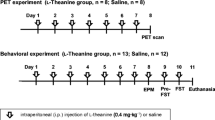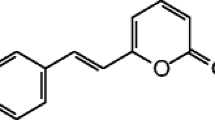Abstract
Evidence of an important role of D-serine, a co-agonist of the glycine site of NMDA receptor, in pathogenesis of psychiatric disorders continues to accumulate. Possible ways of using D-serine for correcting cognitive impairments and negative symptoms in schizophrenia are widely discussed. Given the therapeutic potential of D-serine, it seems important to investigate its effect on experimental models of pathological behavior. This study was carried out on GC rats, proposed as a model of catatonic disorders, and Wistar rats, undisposed to catatonic reactions. In numerous studies, D-serine is used at fairly high doses, although it has been established that high doses of D-serine elicit adverse side effects. The aim of this study was to investigate the effect of low D-serine doses on the behavior of GC rats and control Wistar rats in the light–dark box and elevated plus maze tests, as well as on their learning ability in the Barnes maze. It was found that intraperitoneal injection of 50 mg/kg D-serine had both anxiolytic and procognitive effects on Wistar rats. In GC rats, a D-serine dose of 100 mg/kg reduced locomotor activity in the elevated plus maze test, while at 50 mg/kg, D-serine reduced locomotor activity in the Barnes maze, but did not affect escape latency.



Similar content being viewed by others
REFERENCES
Kantrowitz J, Javitt DC (2012) Glutamatergic transmission in schizophrenia: from basic research to clinical practice. Curr Opin Psychiatry 25(2):96–102. https://doi.org/10.1097/YCO.0b013e32835035b2
Kawaura K, Koike H, Kinoshita H, Kambe H, Kaku A, Karasawa J, Chaki S, Hikichi H (2015) Effects of a glycine transporter-1 inhibitor and D-serine on MK-801-induced immobility in the forced swimming test in rats. Behav Brain Res 278:186–192. https://doi.org/10.1016/j.bbr.2014.09.046
Stepnicki P, Kondej M, Kaczor AA (2018) Current Concepts and Treatments of Schizophrenia. Molecules 23: 2087. https://doi.org/10.3390/molecules23082087
Elvevag B, Goldberg TE (2000) Cognitive impairment in schizophrenia is the core of the disorder. Crit Rev Neurobiol 14:1–21.
Ross CA, Margolis RL, Reading SAJ, Pletnikov M, Coyle JT (2006). Neurobiology of schizophrenia. Neuron 52: 139–153.
Cho SE, Na KS, Cho SJ, Kang SG (2016) Low d-serine levels in schizophrenia: A systematic review and meta-analysis. Neurosci Lett 634:42–51. https://doi.org/10.1016/j.neulet.2016.10.006
Coyle J, Balu T (2018) The Role of Serine Racemase in the Pathophysiology of Brain Disorders. Adv Pharmacol 82: 35–56. https://doi.org/10.1016/bs.apha.2017.10.002
Labrie V, Wong A, Roder JC (2012) Contributions of the D-serine pathway to schizophrenia. Neuropharmacology 62:1484–1503. https://doi.org/10.1016/j.neuropharm.2011.01.030
Kantrowitz J, Malhotra A, Cornblatt B, Silipo G, Balla A, Suckow R, D’Souza C, Saksa J, Woods S, Javitt D (2010) High dose D-serine in the treatment of schizophrenia. Schizophr Res 121:125–130. https://doi.org/10.1016/j.schres.2010.05.012
Kantrowitz JT, Epstein ML, Lee M, Lehrfeld N, Nolan KA, Shope C, Petkova E, Silipo G, Javitt DC (2018) Improvement in mismatch negativity generation during d-serine treatment in schizophrenia: Correlation with symptoms. Schizophr Res 191:70–79. https://doi.org/ 10.1016/j.schres.2017.02.027
Panizzutti R, Fisher M, Garrett C, Man WH, Sena W, Madeira C, Vinogradov S (2019) Association between increased serum D-serine and cognitive gains induced by intensive cognitive training in schizophrenia. Shizophr Res 207:63–69. https://doi.org/ 10.1016/j.schres.2018.04.011
Avellar M, Scoriels L, Madeira C, Vargas-Lopes C, Marques P, Dantas C, Manhães A, Leite H, Panizzutti R (2016) The effect of D-serine administration on cognition and mood in older adults. Oncotarget 7(11):11881–11888. https://doi.org/10.18632/oncotarget.7691
Coyle JT, Basu A, Benneyworth M, Balu D, Konopaske G (2012) Glutamatergic synaptic dysregulation in schizophrenia: Therapeutic implications. Handb Exp Pharmacol 213:267–295. https://doi.org/10.1007/978-3-642-25758-2_10
Otte DM, Arellano de MLB, Bilkei-Gorzo A, Albayram O, Imbeault S, Jeung H, Alferink J, Zimmer A (2013) Effects of Chronic D-Serine Elevation on Animal Models of Depression and Anxiety-Related Behavior. PLOS ONE 8(6):e67131. https://doi.org/10.1371/journal.pone.0067131
Andersen J, Pouzet B (2004) Spatial memory deficits induced by perinatal treatment of rats with PCP and reversal effect of D-serine. Neuropsychopharmacology 29:1080–1090. https://doi.org/10.1038/sj.npp.1300394
Guercio GD, Bevictori L, Vargas-Lopes C, Madeira C, Oliveira A, Carvalho VF, d’Avila JC, Panizzutti R (2014) D-serine prevents cognitive deficits induced by acute stress. Neuropharmacology 86:1–8. https://doi.org/10.1016/j.neuropharm.2014.06.021
Chen XG, Wang YH, Wen CC, Chen YH (2014) Overdose of D-serine Induces Movement Disorder and Neuromuscular Changes of Zebrafish Larvae. J Toxicol Pathol 27: 19–24. doi: 10.1293/tox.2013–0032
Rais R, Thomas AG, Wozniak K, Wu Y, Jaaro-Peled H, Sawa A, Strick CA, Engle SJ, Brandon NJ, Rojas C, Slusher BS, Tsukamoto T (2012) Pharmacokinetics of oral D-serine in D-amino acid oxidase knockout mice. Drug Metab Dispos 40(11):2067–2073. https://doi.org/ 10.1124/dmd.112.046482
Ganote CE, Peterson DR, Carone FA (1974) The nature of D-serine-induced nephrotoxicity. Am J Pathol 77(2):269–282.
Krug AW, Volker K, Dantzler WH, Silbernagl S (2007) Why is D-serine nephrotoxic and alpha-aminoisobutyric acid protective? Am J Physiol Renal Physiol 293:382–390. https://doi.org/10.1152/ajprenal.00441.2006
Kolpakov VG, Kulikov AV, Alekhina TA, Chuguy VF, Petrenko OI, Barykina NN (2004) Catatonia or depression: The GC rat strain as an animal model of psychopathology. Genetics (Moscow) 40(6):827–834 https://doi.org/10.1023/B:RUGE.0000033315.79449.d4
Kulikov AV, Kolpakov VG, Popova NK (2006) The genetic cataleptic (GK) rat strain as a model of depression disorders. In: Kalueff AV (ed) Animal models in biological psychiatry, 1st edn. Nova Science Pub Inc, New York 59–73.
Ryazanova MA, Prokudina OI, Plekanchuk VS, Alekhina TA (2017) Expression of catecholaminergic genes in the midbrain and prepulse inhibition in rats with a genetic catatonia. Vavilovskii Zhurnal Genetiki i Selektsii 21(7):798–803 https://doi.org/10.18699/VJ17.296
Barykina NN, Alekhina TA, CHuguj VF, Petrenko OI, Plyusnina IF, Kolpakov VG (2004) Bipolar manifestation of cataleptic reactions in rats. Russ J Genet 40(5):485−490 (In Russ).
Alekhina TA, Prokudina OI, Chuguj VF, Shihevich SG, Barykina NN, Kolpakov VG (2005) Dual manifestation of catatonic reaction in rats. Zh Vyssh Nerv Deiat Im I P Pavlova 55(4): 536–542 (In Russ).
Barnes CA (1979) Memory deficits associated with senescence: a neurophysiological and behavioral study in the rat. J Comp Physiol Psychol 93(1):74–104. https://doi.org/10.1037/h0077579
Stansley BJ, Yamamoto BK (2015) Behavioral impairments and serotonin reductions in rats after chronic L-dopa. Psychopharmacology (Berl) 232(17): 3203–3213. https://doi.org/10.1007/s00213-015-3980-4
Hasegawa H, Masuda N, Natori H, Shinohara Y, Ichida K (2019) Pharmacokinetics and toxicokinetics of D-serine in rats. Journal of Pharmaceutical and Biomedical Analysis 162:264–271. https://doi.org/10.1016/j.jpba.2018.09.026
Walf AA, Frye CA (2007) The use of the elevated plus maze as an assay of anxiety-related behavior in rodents. Nat Protoc 2(2):322–328. https://doi.org/10.1038/nprot.2007.44
Rodgers RJ, Johnson NJ (1995) Factor analysis of spatiotemporal and ethological measures in the murine elevated plus-maze test of anxiety. Pharmacol Biochem Behav 52:297–303. https://doi.org/10.1016/0091-3057(95)00138-m
Gawel K, Gibula E, Marszalek-Grabska M, Filarowska J, Kotlinska HJ (2019) Assessment of spatial learning and memory in the Barnes maze task in rodents - methodological consideration. Naunyn-Schmiedeberg's Archives of Pharmacology 392(1):1-18. https://doi.org/10.1007/s00210-018-1589-y
Wang XQ, Zhong XL, Li ZB, Wang HT, Zhang J, Li F, Zhang JY, Dai RP, Xin-Fu Z, Li CQ, Li ZY, Bi FF (2015) Differential roles of hippocampal glutamatergic receptors in neuropathic anxiety-like behavior after partial sciatic nerve ligation in rats. BMC Neurosci 16:14. https://doi.org/10.1186/s12868-015-0150-x
Bado P, Madeira C, Vargas-Lopes C, Moulin TC, Wasilewska-Sampaio AP, Maretti L, de Oliveira RV, Amaral OB, Panizzutti R (2011) Effects of low-dose D-serine on recognition and working memory in mice. Psychopharmacology (Berl) 218(3):461–470. https://doi.org/10.1007/s00213-011-2330-4
Stouffer EM, Petri HL, Devan BD (2004) Effect of d-serine on a delayed match-to-place task for the water maze. Behav Brain Res 152:447–452. https://doi.org/10.1016/j.bbr.2003.10.008
Zhang Z, Gong N, Wang W, Xu L, Xu TL (2008) Bell-shaped D-serine actions on hippocampal long-term depression and spatial memory retrieval. Cereb Cortex 18(10):2391–2401. https://doi.org/10.1093/cercor/bhn008
Nong Y, Huang YO, Ju W, Kalia LV, Ahmadian G, Wang YT, Salter MW (2003) Glycine binding primes NMDA receptor internalization. Nature 422(6929):302–307. https://doi.org/10.1038/nature01497
Rodgers RJ, Howard K, Stewart S, Waring P, Wright FL (2010) Anxioselective profile of glycine B receptor partial agonist, D-cycloserine, in plus-maze-naïve but not plus-maze-experienced mice. Eur J Pharmacol 646(1–3):31–37. https://doi.org/10.1016/j.ejphar.2010.08.005
Schmitt ML, Coelho W, Lopes-de-Souza AS, Guimarães FS, Carobrez AP (1995) Anxiogenic-like effect of glycine and D-serine microinjected into dorsal periaqueductal gray matter of rats. Neurosci Lett 189:93–96. https://doi.org/ 10.1016/0304-3940(95)11459-a
Wu SL, Hsu LS, Tu WT, Wang WF, Huang YT, Pawlak CR, Ho YJ (2008) Effects of d-cycloserine on the behavior and ERK activity in the amygdala: Role of individual anxiety levels. Behav Brain Res 187:246–253. https://doi.org/10.1016/j.bbr.2007.09.013
Ho YJ, Hsu LS, Wang CF, Hsu WY, Lai TJ, Hsu CC, Tsai YF (2005) Behavioral effects of d-cycloserine in rats: the role of anxiety level. Brain Res 1043:179–185. https://doi.org/10.1016/j.brainres.2005.02.057
Funding
This work was supported by the Russian Foundation for Basic Research grant No. 17-04-01631-А and budget project No. 0259-2021-0016. It was implemented using the equipment of the CCU “Center for Genetic Resources of Laboratory Animals” at the Institute of Cytology and Genetics (Novosibirsk) supported in turn by the Ministry of Education and Science of the Russian Federation (unique project identifier RFMEFI62119X0023).
Author information
Authors and Affiliations
Contributions
Idea and experimental design (O.I.P.); data collection (O.I.P. and T.A.A.); data processing (O.I.P.); writing and editing the manuscript (O.I.P. and T.A.A.).
Corresponding author
Ethics declarations
CONFLICT OF INTEREST
The authors declare that they have no conflict of interest that might be related to the publication of this material.
Additional information
Translated by A. Polyanovsky
Russian Text © The Author(s), 2021, published in Zhurnal Evolyutsionnoi Biokhimii i Fiziologii, 2021, Vol. 57, No. 6, pp. 510–518https://doi.org/10.31857/S0044452921060085.
Rights and permissions
About this article
Cite this article
Prokudina, O.I., Alekhina, T.A. Effect of D-serine on Anxiety-like Behavior and Spatial Learning Ability in GC Rats Selected for the Predisposition to Catatonic Reactions. J Evol Biochem Phys 57, 1267–1276 (2021). https://doi.org/10.1134/S0022093021060077
Received:
Revised:
Accepted:
Published:
Issue Date:
DOI: https://doi.org/10.1134/S0022093021060077




